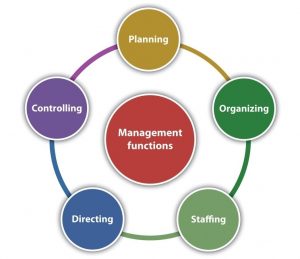Management is a social and dynamic process of doing business. Management is the process of reaching organizational goals by working with people and other organizational resources. It is a process or series of continuing and related activities. It concentrates on reaching organizational goals. An organization achieves its goals by working with people and using organizational resources correctly.
Different experts have classified functions of management. George & Jerry have defined four functions of manageme nt i.e. planning, organizing, actuating and controlling. According to Henry Fayol, “To manage is to forecast and plan, to organize, to command, & to control”. Whereas Luther Gullick has given a keyword ’POSDCORB’ where P stands for Planning, O for Organizing, S for Staffing, D for Directing, Co for Co-ordination, R for reporting & B for Budgeting. But all over world, people and organizations most widely accept functions of management given by KOONTZ and O’DONNEL i.e. Planning, Organizing, Staffing, Directing and Controlling. Because this set of basic functions help to increase efficiency, crystallize the nature of management, they improve research and help to attain goals and objectives.
nt i.e. planning, organizing, actuating and controlling. According to Henry Fayol, “To manage is to forecast and plan, to organize, to command, & to control”. Whereas Luther Gullick has given a keyword ’POSDCORB’ where P stands for Planning, O for Organizing, S for Staffing, D for Directing, Co for Co-ordination, R for reporting & B for Budgeting. But all over world, people and organizations most widely accept functions of management given by KOONTZ and O’DONNEL i.e. Planning, Organizing, Staffing, Directing and Controlling. Because this set of basic functions help to increase efficiency, crystallize the nature of management, they improve research and help to attain goals and objectives.
Planning: This is the basic function of management. It deals with chalking out a future course of action & choosing in advance the most appropriate course of actions for achievement of pre-determined goals. According to KOONTZ, “Planning is deciding in advance – what to do, when to do & how to do. It bridges the gap from where we are and where we want to be”. A plan is a future course of actions. Proper planning exercise helps in problem solving and decision making. Planning is the basic purpose of courses of action to achieve desired goals. Thus, planning is a systematic thinking about ways and means for accomplishment of pre-determined goals.
Planning is necessary to ensure proper consumption of human and other non-human resources such as money, material, machines and raw materials. Planning needs to be persistent, it is an intellectual activity and it also helps in avoiding confusion and uncertainties. It helps in reducing risks, wastage, expenditure etc. Planning is the most elementary managerial functions because all other functions, including organizing, leading, controlling, and staffing, stem from the planning function. To plan efficiently, the manager needs to have strong understanding of the business, the strengths of the organization and the shortcomings. Planning involves flexibility, as the planner must coordinate with all levels of management and leadership in the organization.
Organizing: It is the process of bringing together physical, financial and human resources and developing productive relationship amongst them for achievement of organizational goals. According to Henry Fayol, “To organize a business is to provide it with everything useful or its functioning i.e. raw material, tools, capital and personnel’s.” Organizing is the function of management which follows planning. Organizing is a function in which the synchronization and combination of human, physical and financial resources takes place. All the three resources are important to get results. Therefore, organizational function helps in achievement of results which in fact is important for the functioning of a concern. According to Chester Barnard, “Organizing is a function by which the concern is able to define the role positions, the jobs related and the co-ordination between authority and responsibility. Hence, a manager always has to organize in order to get results”. Organizing begins with identification of activities, grouping the activities, distributing the activities departmentally, assigning the duties, identifying and giving authority to individuals to execute the work, then coordinating between authority and responsibility.
Staffing: It is the function of manning the organization structure and keeping it manned. It is the function or process of selecting and training of individuals for specific job functions, and charging them with the associated responsibilities. It involves employee recruitment, screening and selection performed within an organization or business to fill job openings. Other areas of staffing are orientation, training, performance appraisal, promotion, retention and termination. The function of staffing is sometimes handled by an outsourced organization by using contractors at various levels of the staffing process. Small organizations handle staffing on a case-by-case basis, while larger organizations prefer to go through multiple staffing cycles during a single year. Organizations of any size also use the option of acquiring temporary or permanent employees.
Staffing has assumed greater importance in the recent years due to advancement of technology, increase in size of business, complexity of human behavior etc. The main purpose o staffing is to put right man on right job. According to Kootz & O’Donell, “Managerial function of staffing involves manning the organization structure through proper and effective selection; appraisal & development of personnel to fill the roles designed in the structure”. Staffing becomes irrelevant without manpower planning. Talent acquisition is a big responsibility in today’s scenario because the talent gaps are becoming wider.
Directing: This is the managerial function which means guiding also. It is a basic management function which includes building effective work culture, creating opportunity for growth of employees by motivating, supervising, scheduling, and disciplining them. Directing is said to be a process in which the managers instruct, guide and oversee the performance of the workers to achieve predetermined goals. Wrong direction leads to misfortune of an organization. Planning, organizing, staffing becomes unconnected if direction goes wrong. This function initiates action and it is from here the actual work starts. Direction is said to be consisting of human factors. In simple words, it can be described as providing guidance to workers. It involves designing organizational methods to work efficiently for achieving organizational purposes. It is considered most complex because it sets in motion the action of people. Planning, organizing and staffing are the preliminary steps or preparations for doing the work. Direction is that inert-personnel aspect of management which deals directly by influencing, guiding, supervising, motivating subordinates for the achievement of organizational goals. Direction involves other elements such as supervision, motivation, communication and leadership.
Controlling: This function implies measurement of accomplishment against the standards and correction of deviation if any to ensure achievement of organizational goals. Management control system (MCS) is a system which gathers and uses information to evaluate the performance of different organizational resources like human, physical, financial and also the organization as a whole in light of the organizational strategies pursued. The purpose of controlling is to ensure that everything occurs as per the plan and as per the standards. An efficient system of control helps to predict deviations before they actually occur. According to Theo Haimann, “Controlling is the process of checking whether or not suitable progress is being made towards the objectives and goals and acting if necessary, to correct any deviation”. According to Koontz & O’Donell “controlling is the measurement and correction of performance activities of subordinates in order to make sure that the enterprise objectives and plans desired to obtain them as being accomplished”. Controlling is achieved by taking these steps: establishment of standard operating procedures, timely performance appraisals of employees, measurement of actual performance by comparing actual performance with the standards and finding out deviation. It doesn’t stop here; corrective actions need to be taken to fill the gaps.
Conclusion: effective management and leadership involve innovative ways for problem solving, motivating employees and making sure that the organization accomplishes objectives and goals. The above five functions of management and leadership: planning, organizing, staffing, coordinating and controlling help the managers in mapping out and executing the business processes. An organization’s culture consists of the values, beliefs, attitudes, and behaviors that employees share and use on a daily basis in their work. The culture determines how employees behave in the workplace; how they understand the business, and how they see themselves as part of the organization. When managers perform their basic functions appropriately the culture of the organization automatically improves.













































